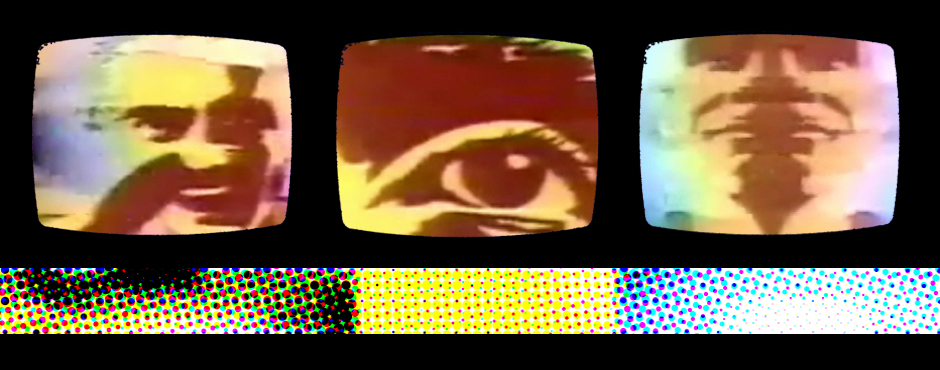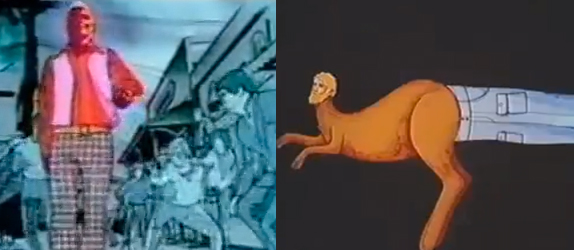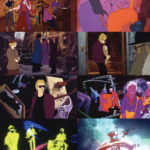PSYCHEDELIC INTERSTITIALS
An interview with Chris Blum, the animator behind the weirdest Levis commercials you’ve ever seen
”There was a stranger who came into our town. He was tall and had eyes that could look right to the bottom viagra online without a prescription of you. We might have welcomed him except for one thing…..his pants..”
Thus viagra now began another hidden gem sealed inside a Miskatonic class.
In between the 70s made-for-TV horror films that served as part of Miskatonic’s 6-week ”Small Screens, Big Chills: Classic American TV Horror” course, students were treated with a few classic commercials of the decade. One of these was an old Levi’s commercial called ”The Stranger.” Overwhelmingly hypnotic, fantastic, gripping, absurd, and beautiful.
The gorgeously animated jeans commercial serenaded the viewer in the form of a ”stranger” who comes into town to change everyone’s perception of PANTS. Blowing everyone’s mind with his PANTS. Everyone in this town had normal, boring pants to begin with, but this stranger walks their way and starts to point here and there, magically changing the town’s complacent pant-wearers into those donning ”Levi’s slacks, and jeans, tweeds, cords, flares with dacron polyester…”
A quest was undertaken to find out whose hands had created such an viagra professional scam explosion of moving, psychedelic, beautiful, 70s animated bodies. Such a visual delight, and all done to a voice over by Word Jazz artist Ken Nordine. Surely the artistic vision that spawned this commercial could not have just dissolved and disappeared? How did such an eccentric story and style get attached to Levi’s? Why did it exist?
Upon further investigation, I turned up a few other commercials made in a similar style, and created by the same man.
Chris Blum is that cialis fast delivery usa man. The man with the special hands that created this wondrous commercial and many others.
His background as an animator is extremely rich, packed with an amazing history that included meeting Disney’s surviving ”old men” and the not-so-tiny feat of helping to develop the rotoscope technique! And as it turns out, he also directed the long-unreleased Tom Waits concert film Big Time, after being introduced to Waits by a mutual private detective friend.*
But first, back to the beginning…
Esinam Beckley: Can you talk about how your career as an animator started?
Chris Blum: I was deeply affected by Walt Disney (my hero); in fact I probably learned the basics of moral behavior from Pinocchio when I was 8 or 9 years old. As a result I was fascinated by animation as a child and it never left me. When I first started working as a professional artist and art director I was only working with still images (Graphic design, illustration, typography etc.) I wanted to see what my images would look like in motion. I was very young, working as an apprentice in an advertising agency in 1964 and there was a man working there named Alex Anderson. He was the originator of Crusader Rabbit, which was an animated cartoon series on TV in the 1950s. It was the beginning of TV and I was fascinated by it as a kid – along with millions of other people (I know it’s hard for someone your age to imagine a world without TV, but up until 1950 there was no such thing – I was born in 1944).
A side note . . . the first image I saw on TV was a nature film of a bear cub. There was a doctor in the neighborhood who was the first one to have a TV, and one night a week he would let kids from around the neighborhood come and watch in the early evenings, that was probably 1951 or 1952. My parents did not get a TV until about 1954.
Back to your question- Alex was working on an animated commercial for “Chicken of the Sea” tuna fish, and at one point there were many animation cels spread all around the office. This was the first time I ever saw an animation cel. I had an immediate understanding when I saw the sequential cels with their Acme Peg registration punched holes. It was like a picture of the whole process became very clear to me. Being a junior art director there was no way I was going to get to work on one of these great projects. I was only given work that the senior art directors did not want. Keep in mind there was very little chance to work on TV projects in San Francisco where I was. Most of the TV commercials were being done in LA or New York. Very, very few in SF.
A job opened up at the worst advertising agency in SF- they were known for doing very bad work, but they did a lot of TV ads so I went to work there hoping to get closer to TV work, as I knew it was “the future”. I was given the Levi Strauss account – all print, no TV – but after about 6 months they decided to try doing a TV commercial as they only had distribution in the 11 western states and they were trying to get national distribution and coming out with pants other than blue jeans, A-HA! Here was my chance. I knew it had to be great, and I knew it had to stand out. 99% of all TV commercials were traditional live action, so I thought everyone else is zigging, I will zag. I designed the first Levis spot based on evolution and WOW, did it stand out because of the subject matter and because of the animation.
That was the beginning of 18 years I spent working on Levi’s and doing every kind of animation known – including morphing into some of the very first computer generated animation. In those 18 years not only did Levis go national, but then into Europe and then South America and then into Asia. GLOBAL. And it all started with that first animated commercial.
EB: How did you come up with the idea for ”The Stranger” and the several other commercials you animated for Levi’s?
CB: I collaborated with a writer, Mike Koelker, for 18 years. Mike had polio when he was younger (another thing that someone of your age is unaware of), and as a result he stayed in the house for most of his childhood and became an avid reader. He was extremely knowledgeable, very intelligent and, like myself, a total pop culture freak. He knew the Greek Classics, he knew Shakespeare and he knew comic books and science fiction and any and all things in between. We were a team. We became unstoppable in what we were doing. We were constantly pondering the most powerful and effective way to make commercials. It became kind of a contest for us. There were ways of testing the work we were doing- such as, day-after telephone surveys that asked people if they recalled any of the commercials they had seen the previous evening. The Levis commercial test scores were going through the roof- higher scores than anyone had ever seen! Then the testing became much more sophisticated – things like pupil dilation, measure of perspiration, body temperature, and heart rate were able to be measured while people were watching commercials in test environments and we still were breaking test score records.
As a result we kept doing more extreme commercials, such as “The Stranger”. . .
Consider that the oldest and most effective story in the world is the story of Christ or Muhammad or Buddha. Now bring it forward to Superman, Batman, or Iron man . . . an unknown man appears with extreme powers and abilities, he creates change and earns a cult- like heroic mythical status, and then leaves.
So we created and concocted “The Stranger” based on Jesus Christ, Ulysses and the Lone Ranger. We knew it would work because we knew the formulas were already proven. Both Mike and I were familiar with a Word Jazz vocal artist in Chicago named Ken Nordine and we remembered a piece he had written in the late 50’s on a similar subject (see below). We contacted Ken and then proceeded to work with him as the originator, voice, and music director of what became “The Stranger”. You might find it interesting that Ken was behind the horrific noises and sounds that came from the little girl in The Exorcist. If you look online you can find a recording of this, it’s really worth the search.
– interlude –
“FLIBBETY JIB” – Ken Nordine [“Word Jazz” – Dot Records DLP 3075]
00:00 – Wordless chorus – uh-ah..uh-ah
THERE WAS THIS STRANGER WHO CAME INTO OUR TOWN. HE WAS TALL AND HAD A DARK LOOK ABOUT HIM – AND A SPECIAL BRILLIANCE IN HIS EYES. . WHEN HE LOOKED AT US, THERE WAS THE FEELING THAT HE COULD LOOK RIGHT DOWN TO THE BOTTOM. WE MAY HAVE BEEN MISTAKEN IN THIS, BUT AT THE TIME, NO QUESTIONS WERE ASKED. THE QUESTIONS ALWAYS COME LATER. ALL WE CARED ABOUT WAS THE MYSTERY WE SENSED IN THIS STRANGER AND WE WAITED TO SEE WHAT WOULD HAPPEN.
ONE EVENING, THAT WAS DIFFERENT FROM ANY OTHER, HE GOT US ALL TOGETHER IN THE BIG AUDITORIUM. HE STOOD THERE ON THE HUGE STAGE, THE ONLY LIGHT WAS ON HIM AND WE WAITED IN THE DARK. THEN, OUT OF HIS TALLNESS CAME THE CHANTING – FIRST, AS A WHISPER WE COULD HARDLY HEAR. “FLIBBETY JIB BOM, THE BIPPETY BOP…FLIBBETY JIB BOM, THE BIPPETY BOP” IT DIDN’T MAKE ANY SENSE!
WE WERE CAUGHT UP IN SOMETHING WE DIDN’T UNDERSTAND. HE HAD TRAPPED US, WITHOUT OUR KNOWING IT. POSSIBLY, IT WAS HIS MANNER, AND WE CAME ALIVE TO HIM. THEN, AS HE SLOWLY MOVED US WITH HIS CHANTING THROUGH THE LAND OF HUSH, INTO INSISTENT, THROBBING CRESCENDOS OF ECSTASY – AS IF IT WERE THE ONLY THING WE COULD DO!
WE STARTED TO CHANT WITH HIM…”THE FLIBBETY JIB BOM, THE BIPPETY BOP…THE FLIBBETY JIB BOM, THE FLIPPETY BOP.” AND, HE WAS UP ON THE HIGH STAGE, LAUGHING WITH ALL HIS MIGHT, SHOUTING, “YES! YES! YES!”
BUT, THERE WERE THOSE AMONG US WHO WERE JEALOUS OF HIS POWERS, WHO FELT THAT THEY SHOULD BE IN THE CENTER OF THE STAGE, WITH THE LIGHT SHINING ON THEM. THEY WERE AGAINST OUR HERO AND THE CHANTING AND OUR GOING TO BE WITH HIM EVERY FREE MOMENT.
AND SO, LITTLE BY LITTLE – A LITTLE LATER – THESE CRITICS SET TO WORK TO MAKE NONSENSE OUT OF THE SENSE OF WHAT WE WERE DOING – – AND THEY SUCCEEDED. THEY DESTROYED OUR HERO’S FAITH IN HIMSELF. HE DIDN’T HAVE IT ANYMORE. AFTER A FEW DISAPPOINTING TIMES IN THE BIG AUDITORIUM, THE LIGHT GONE OUT OF HIM, WE ALL STOPPED GOING. AND THE MAN WHO ONCE HAD SEEMED SO TALL – WHO NOW SEEMED SO MUCH SMALLER – LEFT OUR TOWN, SAYING “NO, NO, NO.”
WE LIVED THROUGH THE BOREDOM OF THE TIME THAT FOLLOWED, TELLING EACH OTHER PALE STORIES OF WHAT ONCE WAS AND WHAT MIGHT HAVE BEEN – IF. WE LIVED ON HISTORIES AND HOPES. WE DID THIS UNTIL THE MIRACLE WE THOUGHT WOULD NEVER HAPPEN, HAPPENED AGAIN!
ANOTHER STRANGER CAME INTO OUR TOWN AND HE WAS TALL AND DARK AND HAD EYES THAT COULD LOOK RIGHT DOWN INTO THE BOTTOM OF YOU.
AND HE GOT US ALL TOGETHER IN THE BIG AUDITORIUM AND WITH THE LIGHT ON HIM – WE WERE IN THE DARK – HE CHANTED: “FLIPPETY JIB BOM, THE BIPPETY BOP, THE FLIPPETY JIB BOM, THE BIPPETY BOP” AND, WE JOINED IN AND THE MAGIC WAS IN US! AND HE WAS LAUGHING AND ALL HIS MIGHT WAS WITH HIM, SHOUTING “YES! YES! YES!”
BUT – – – THERE WERE THOSE AMONG US WHO WERE JEALOUS – – AND SO FORTH. YOU KNOW WHAT THEY DID. LITTLE BY LITTLE, A LITTLE LATER, THEY PUT US BACK ON THE NARROW PATH.
THIS IS THE WAY THINGS HAVE BEEN IN OUR TOWN FOR AS LONG AS ANYONE CARES TO REMEMBER. [whispers] BY THE WAY – – – HOW ARE THINGS IN YOUR TOWN?
– end of interlude –
EB: Can you talk a bit about the ”Rotoscope” technique and the history behind it as well as your contribution or experience with using it?
CB: I was actually very upset at Ralph Bakshi as he took credit for the “rotoscope” technique that I helped revive in the late sixties – 2 or 3 years before he did Fritz the Cat. I say revive because it was originally a technique developed by Disney Studios and they had last used it in 1949 on Song of the South. I was lucky enough to meet the surviving “Old Men” at Disney Studios . . . I went to them to try to get them to do a Levi’s commercial for me, but Disney Studios was not doing commercials in those days – but they told me the secret of the technique, which I then developed with Linda Taylor, a young British girl who had recently moved to Los Angeles to do animation.
EB: At the time you were animating were there trends in animation? What were they like?
CB: Yellow Submarine was in the theaters so there was a lot of derivative work of that sort going on. There was also still some of the classic Looney Tunes animation, but that style was on its way out as it looked dated and was very hard to do. Robert Blechman, a really good illustrator, was doing some animation that was kind of a naive squiggly line style. There was also another interesting technique being used that was pen and ink; there was a great example of this in The Charge of the Light Brigade. There was no CGI and very little limited Japanese animation.
I think I told you earlier, but if not . . . I saw Disney’s Song of the South and somehow the projector had shifted and was misaligned, and at the bottom of the screen I could see a vague image of live action footage. I realized that this was how the animation artists were getting such great draftsmanship. This was my first awareness of rotoscoping. All the animation I had seen prior to this had herky-jerky movement and never had really good human anatomy and fluid movement, the way people actually move. This awareness caused me to learn about rotoscoping and was the start of many commercials I did using that technique.
EB: Do you still have interest in film/animation now? What are some of your personal artistic interests?
CB: I am doing some very limited animation for web site design chrisblum.com and studies for a game being developed to encourage weight loss. I can only do this work now because of my background in animation. In fact much of what I now do, I could not be doing without my background in animation. I easily adapted to using a computer to make and move images because the basic visual engineering is pretty much the same. Naturally the materials are completely opposite ( brush and paint versus digits and pixels), but the conceptual mechanics are very similar.
As far as my current artistic interests, I am doing some Dioramas at blumboxart.com– and the ability to work in that area also comes from filmmaking. When I was directing, quite often I would have tabletop models made for set design, lighting analysis, camera positions, and blocking. So I was used to dealing with that small scale.
Interview with animator Chris Blum, July 28, 2013
———————–
* As Blum pointed out in an interview on the Tom Waits fansite The Mule HERE, neither Blum nor Waits own the rights to Big Time – MGM acquired them when they bought the now-defunct Vivid Productions – but fans can join a Facebook Group aimed at getting it the Criterion Treatment HERE.

 August 31, 2013
August 31, 2013  No Comments
No Comments









